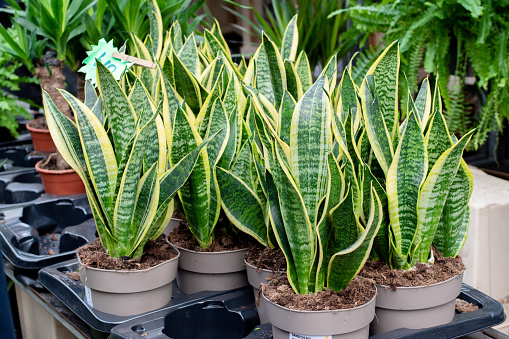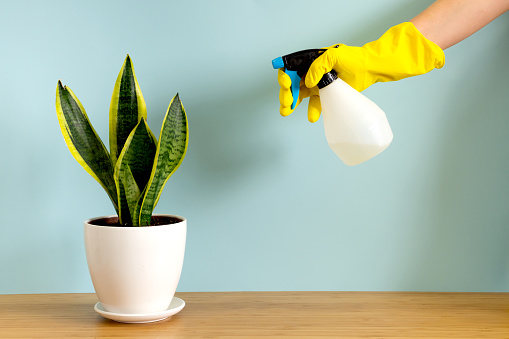Snake Plant Turning Yellow And Soft (Causes and Solutions)
Hey folks! welcome back! we are here with another informative topic that will help you in your gardening field. You might have grown a Snake plant in your home garden as it is one of the most famous plants worldwide. Snake plants are easy to care for and can tolerate neglect. They are also known for their ability to purify the air of toxins and improve indoor air quality.
Quick takeaways:
- The snake plant is a beautiful and hardy houseplant that is native to Africa. It is also known as the Sansevieria or mother-in-law’s tongue.
- sometimes snake plants can turn yellow and soft. There are a few different reasons why this may happen, and there are also a few solutions.
- Some of the causes of the Snake Plant Turning Yellow And Soft are exposure of sunlight to the plants, excess supply of water to the plants, sunburn, pest issues, nutrient deficiency, and many more.
- There are some solutions too that can help you fix this issue.
- If you have a snake plant (Sansevieria trifasciata) with yellow leaves, don’t worry – this is normal! Snake plants are known for their ability to tolerate neglect, and they will often go through periods of yellowing when they are not receiving enough water or light.
However, if the leaves are persistently yellow or soft, this could be a sign of a problem. So, let’s get started to know about the Snake Plant Turning Yellow And Soft.
Snake Plant Turning Yellow And Soft (Causes and Solutions)
1. Sun Burn
If your snake plant is turning yellow and soft, it’s likely due to sunburn. Snake plants are native to tropical regions and prefer bright, indirect light. However, they can tolerate full sun if they’re gradually acclimated to it.
If you live in a hot climate or your plant is in a particularly sunny spot, the leaves may start to turn yellow and soften. This is a sign that the plant is stressed and needs to be moved to a shadier spot.
You can also try misting the leaves with water to help cool them down and prevent further stress. If the leaves are already severely damaged, you can trim them off and encourage new growth from the base of the plant. It will fix the issue of the Snake Plant turning Yellow And Soft.

How to fix this?
If your snake plant’s leaves are turning yellow and soft due to sunburn, there are a few things you can do to save it. First, move the plant out of direct sunlight. Second, water the plant deeply and regularly, making sure the soil is evenly moist but not soggy.
Third, apply a light fertilizer monthly during the growing season. Finally, if the leaves are severely damaged, you can cut them off at the base. It will fix the issue of the Snake Plant turning Yellow And Soft.
2. Snake Plant Leaves Turning Yellow, Wrinkled, and Crispy
If your snake plant leaves are turning yellow and wrinkled, it’s likely due to too much water. The leaves of the snake plant are thick and fleshy, which means they hold a lot of water.
When the plant is overwatered, the leaves can’t get rid of the excess water or overwater fast enough and they start to turn yellow and wilt.
How to fix this?
To prevent your snake plant from overwatering, water it only when the soil is dry to the touch. If you’re not sure when to water, stick your finger into the soil up to the first knuckle. If the soil is dry at that level, it’s time to water.
In addition to watering only when necessary, make sure you’re using a well-draining potting mix. A mix that doesn’t drain well will hold onto too much moisture, which can lead to root rot and eventually kill your plant.
If your snake plant’s leaves are already yellow and wilted, you can try reviving it by giving it a thorough watering and then letting the soil dry out completely before watering again. Be sure to check the drainage of your potting mix before doing this as you don’t want to risk overwatering and further damaging your plant. It will fix the issue of the Snake Plant turning Yellow And Soft.
3. Overwatering
Overwatering your snake plant is one of the most common reasons for yellow leaves. Snake plants are native to dry, arid regions, so they don’t need a lot of water. In fact, too much water can be detrimental to their health.

If you think you’re overwatering your snake plant, the first thing you should do is let the soil dry out completely before watering again.
You can also try watering with less water or underwatering more often, instead of giving them a large amount all at once. It will fix the issue of the Snake Plant turning Yellow And Soft.
4. Aging
The snake plant might be turning yellow due to aging as well. You need to understand and memorize when you bought or planted it, as it may be too long a time since the snake plant has started to age.
How to fix this?
Aging is a part of the life cycle and the plant will die afterward. Provide good care to your old buddy or you can buy a new healthy snake plant from a nursery as well.
5. Infestations
The infestations of pests or fungus can lead to the discoloration of the snake plant leaves. The pests like aphids, and mealy bugs, can suck the sap of the leaves and lead to a deficiency of nutrients in the plant that can cause the weakening of the plant.
The yellow leaves will appear and they droop. The eggs, larvae of the pest, and even fungus can cause spots and color on the leaves as well like sooty mold.
How to fix this?
Use a good organic fungicide and spray it on the affected parts. Use neem oil to kill the pests like aphids, etc. Use a good quality pesticide and fungicide.
6. Diseases
The snake plants that have gone weak and are stressed get easily attacked by fungal infections and some bacterial diseases too.
Anthracnose, southern blight, root rot, fungal leaf spot, and bacterial leaf spots are some of the diseases that can cause yellow leaves.
How to fix this?
Keep the snake plants healthy and keep the roots away from rot. This can be done by checking the drainage of soil and spraying fungicide on the soil and plant. The snake plants should get proper sunlight.
7. Poor drainage
If the soil does not have good drainage, the plant will become soft due to not getting eight and trying to save stored water. The nutrients will also get deficient in the plant as the roots get affected.
All this happened due to the poor drainage of the soil. If the soil is compact then the water will stand and not drain properly leading to root rot. The waterlogged soil will not only affect the roots but also the stem.
How to fix this?
The soil needs to be watered once the soil gets dry or doesn’t water at all. The soil should be mixed with a little perlite and sand to increase the drainage, the snake plant leaves are looking droopy and soggy then check for drainage holes in the pot. Repot the plant to a good well-draining pot.
“Trees are poems that the earth writes upon sky”
– By Khalil Gebran
8. Cold Temperature
The snake plant is sensitive to low temperatures. The plants being hardy thrive well in the temperature range of 50-70 degrees Fahrenheit. The temperature falls below 45 degrees Fahrenheit means the plant will get yellow leaves as the plant gets temperature shock.
If the cold weather or cold conditions are prolonged then the yellow leaves will fall and the plant might die.
How to fix this?
Keep the conditions not too cold inside the house. The snake plants can be moved to a spot that is warm having a heater. Make sure that the plant is not kept too close to the heat.
9. Root rot
The roots get affected if the soil has fewer pores. The low aeration and too much humid and warm conditions lead to fungal growth that can cause root rot. The roots are destroyed with rot which is mainly due to fusarium and pythium fungus that decrease the ability of roots to absorb nutrients and water properly.
How to fix this?
Take out the plant from the pot, check the roots that are rotted and cut them, immerse the plant in fungicide solutions, and let the roots get dry. Repot the plant in the new soil and pot.
10. Nutrient deficiency
Usually, the lack of nitrogen, iron, and magnesium can directly or indirectly lead to the snake plant leaves turning yellow.
The reason can be you are not using nutrient-rich fertilizer, or nutrient that is actually in need, or the pests have overtaken your nutrient-deficient plant that is making the leaves go pale to yellow colored.
How to fix this?
Snake plants should not be overfertilized. Though the plant demands much fertilizer in the early growth stages but decreases it later on like one time a month. Use all-purpose fertilizer for the snake plants in the proportion of 10-10-10.
Wrapping up the Context
In this guide, you come to know that the snake plant is a beautiful and hardy houseplant that is native to Africa. It is also known as the Sansevieria or mother-in-law’s tongue. Snake plants are easy to care for and can tolerate neglect. They are also known for their ability to purify the air of toxins and improve indoor air quality.
However, sometimes snake plants can turn yellow and soft. Some of the causes of the Snake Plant Turning Yellow And Soft are exposure of sunlight to the plants, excess supply of water to the plants, sunburn, pest issues, nutrient deficiency, and many more. There are some solutions too that can help you fix this issue. It will fix the issue of the Snake Plant turning Yellow And Soft.
Thanks for reading! Happy gardening!
FAQs
1. How do you save the yellow snake plants?
If you notice your snake plant’s leaves turning yellow and soft, it’s likely due to too much water. Snake plants are drought-tolerant and don’t like being overwatered. Let the soil dry out between watering, and be sure to use a well-draining pot.
If the leaves are limp and mushy, you can try reviving them by cutting off any yellow leaves and replanting them in fresh, dry soil. It will help the plant to fix the issue of the Snake Plant turning Yellow And Soft.
2. Can yellow snake plant leaves turn green again?
There are several reasons why your snake plant’s leaves might turn yellow or soft. One possibility is that you are overwatering the plant. Snake plants like to be kept on the dry side, and too much water can cause the roots to rot. If you think this might be the problem, allow the soil to dry out completely before watering again.
If your snake plant’s leaves are still yellow or soft after making sure it is getting enough light and water, there could be another problem causing it. For example, excess fertilizer can cause leaf problems in snake plants. If you fertilize your plant regularly, try cutting back on the amount you use or switching to a different fertilizer.
3. What does it mean when a snake plant turns yellow?
When a snake plant turns yellow, it means that the plant is not getting enough light. The leaves of the snake plant will turn yellow if the plant is not getting enough sunlight. The best way to solve this problem is to move the plant to a location where it can get more light.
4. Why is my snake plant turning soft?
If your snake plant is turning yellow and soft, it’s likely due to overwatering. Snake plants are succulents and prefer to be on the drier side, so too much water can lead to root rot, which will cause the leaves to turn yellow and soft.
To fix this problem, you’ll need to allow the soil to dry out completely before watering again. You may also need to repot the plant in fresh, dry soil. If the roots are already rotting, you may need to trim them back before repotting.


